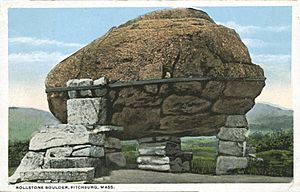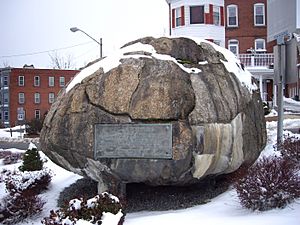Rollstone Boulder facts for kids
The Rollstone Boulder is a huge rock, about ten feet (3 meters) tall and weighing 110 tons! That's like 20 elephants! It's made of a type of rock called porphyritic granite. This giant rock is a "glacial erratic", which means it was carried a long way by a glacier during the Ice Age and then dropped in a new spot. Today, you can find it on a small island in the middle of a road in downtown Fitchburg, Massachusetts. The boulder wasn't always there; it was actually blown up into pieces and then put back together in 1929!
Contents
The Amazing Journey of the Rollstone Boulder
How the Ice Age Moved a Giant Rock
Long, long ago, during the Ice Age, a massive glacier picked up this huge rock. It was about 45 feet (13.7 meters) wide and weighed over 100 tons! The glacier carried it all the way to the top of Rollstone Hill. Over many years, this boulder became a famous spot where people would hike and have picnics.
Saving the Boulder from Quarrying
As time passed, the weather started to wear down the boulder, and by 1899, it had big cracks. People tried to fix it with cement and even put an iron band around it. Meanwhile, people started digging for granite on Rollstone Hill. This granite was used to build many things, like walls, bridges, and even parts of the George Washington Bridge!
By the late 1800s, people worried that the quarrying (digging for rock) would destroy the famous boulder. The Fitchburg Historical Society tried to save it. They talked to the quarry owners, but nothing happened right away. Finally, in 1929, the boulder was in serious danger because the quarries were digging closer and closer to it.
The Big Move: Blasting and Rebuilding
The mayor of Fitchburg, Joseph N. Carriere, stepped in and stopped the quarry work so the boulder could be moved. The plan was to take off the iron band, let the boulder break apart, and then move the pieces to a new spot in downtown Fitchburg. To make sure they could put it back together perfectly, they painted lines and numbers on the boulder and took many photos and drawings.
But here's a surprise: when they removed the iron band, the boulder didn't fall apart! They had to use several blasts of black powder to even crack it. Once it was broken into smaller pieces, they were all moved to its new home.
Putting the Pieces Back Together
A local stonemason named J. Marc Leblanc had the tough job of putting the Rollstone Boulder back together. It was even harder because streetcars kept rumbling by, shaking the stones he had just placed! After months of work, the city ran out of money, and Leblanc couldn't finish the job.
A special committee, led by U.S. Senator Marcus A. Coolidge, took over. They decided the best way to restore the boulder was to use only the outside pieces and fill the inside with concrete. State representative Louis N. M. Des Chenes explained, "We just used the outside and tied the parts together with iron rods... We drilled holes and hooked the rods to the insides of the rock. After the shell of the boulder was fixed in place, Leblanc poured in concrete and filled it up."
After all this work, the Rollstone Boulder looked just like it did before, and it was even placed in the same direction! In 1930, a plaque was put on the boulder. It said the boulder came from Mt. Monadnock in New Hampshire and was saved by people donating money. However, the boulder actually came from central New Hampshire, and no one had to donate money to save it.
What is the Rollstone Boulder Made Of?
The Rollstone Boulder is a type of granite called "porphyritic Kinsman quartz monzonite." This means it has large, visible white feldspar crystals mixed in with other minerals. It weighs about 110 tons and stands 10 feet (3 meters) tall. Scientists believe it traveled to Fitchburg from central New Hampshire, possibly from ridges near the towns of Bradford and Warner, because the rocks there are the same kind.
Places Named After the Rollstone Boulder
The Rollstone Boulder is so famous in Fitchburg that many things are named after it! There's a Rollstone Street and a Boulder Drive. An art gallery downtown is called the "Boulder Art Gallery" because it sits "In the Shadow of the Rollstone Boulder." In 2008, Fitchburg Savings Bank even changed its name to Rollstone Bank and Trust, with the slogan "Rock Solid Banking Since 1846."
Images for kids





